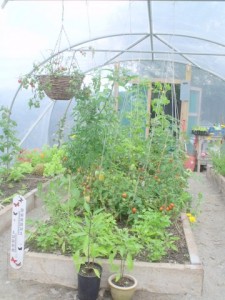Weeds cause the same problems in a greenhouse as in the open garden: they compete with crops for water and minerals, harbour pests and diseases and make gardening more difficult. They also raise the humidity of the air, encouraging grey mould and other fungus problems. And because greenhouses protect weeds from cold and wind in the same way as crop plants, they grow faster than open-ground weeds and create problems sooner.
Before you sow or plant crops in a greenhouse, make sure that the soil is free from perennial weeds like scutch-grass and ground elder. It is hard to dig up every tiny bit of their brittle roots, but you have to do it or they will re-grow from the bits you missed. You could spray their leaves with glyphosate weed killer, but it is hard to keep the droplets off crop leaves unless you spray before planting the crops. Read the instructions before you use garden chemicals: they change over time and you may confuse them with another chemical’s directions or misremember them from last time.
Pull the weeds among growing crops when they are still very small: it’s quicker and easier then, it does less damage to the crop roots and they have no chance to set seed and cause you future work. In the heat of a greenhouse they can seed very quickly, so don’t leave them too long! Check for weeds under staging and low-growing plants, in corners and at the bases of walls. Compost or bury the pulled weeds right away: if you leave them lying around they could release disease spores to infect your crops.
Note from Polydome: Take care about using sprays inside a Glasshouse or Polytunnel. If the spray gets on to your glass or polythene it may well come down onto your plants with condensation. It is safer to use a weed lick or similar device to apply the weed killer without using a spray.





